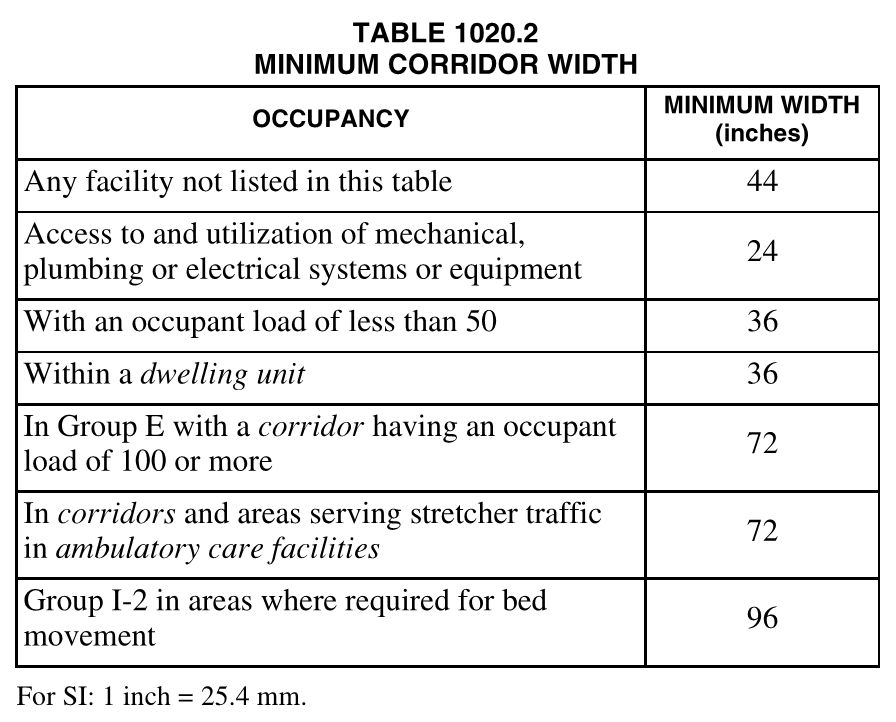 We’ve all seen blocked exits before – especially in restaurants. It’s not uncommon to see a table placed in front of a marked exit, or an egress corridor used for storage. I was a little surprised to see this photo, sent to me by James Hanna of Dave’s Lock & Key, because this is a very well-known fast-food restaurant, and the obstructions are fixed stools.
We’ve all seen blocked exits before – especially in restaurants. It’s not uncommon to see a table placed in front of a marked exit, or an egress corridor used for storage. I was a little surprised to see this photo, sent to me by James Hanna of Dave’s Lock & Key, because this is a very well-known fast-food restaurant, and the obstructions are fixed stools.
James asked about the required egress width between the wall and the stools. The required width varies depending on the use group/occupancy classification and the occupant load. In the International Building Code (IBC), the egress width of the various components of a means of egress (corridors, stairs, doors, etc.) is addressed in Chapter 10.
I would consider the egress component in the photo to be an aisle, defined by the IBC as: An unenclosed exit access component that defines and provides a path of egress travel. The spaces between tables would be aisle accessways: That portion of an exit access that leads to an aisle.
In the 2018 edition of the IBC, aisles and aisle accessways are covered in Section 1018. Generally speaking, there are two dimensions to look at – the minimum egress  width, and the width needed to accommodate the required egress capacity. More occupants = more required egress width. For most use groups, the IBC requires the aisle width to be the same as the width required for corridors. Table 1020.2 shows the minimum corridor widths for various locations.
width, and the width needed to accommodate the required egress capacity. More occupants = more required egress width. For most use groups, the IBC requires the aisle width to be the same as the width required for corridors. Table 1020.2 shows the minimum corridor widths for various locations.
When the aisle is in an assembly occupancy, like the one shown in the photo, there are other factors to consider when calculating the aisle width. We don’t know the occupant load of the restaurant in the photo, but I would assume that it is 50 people or more because of the second exit. If the occupant load is less than 50 people, the minimum width of the aisle is 36 inches and the restaurant would be a business occupancy. For a larger occupant load, the required aisle width would increase.
Based on the position of the stools in relation to the 3-foot-wide door and the +/- 4 inches beside it, my guess is that the aisle width is not 36 inches, let alone wide enough to serve a larger occupant load. What do you think?
For future reference, here’s where the IBC says that reducing the egress width with obstructions is not allowed. The projections referenced in this paragraph typically include doors, handrails, trim and decorative features.
1003.6 Means of egress continuity. The path of egress travel along a means of egress shall not be interrupted by a building element other than a means of egress component as specified in this chapter. Obstructions shall not be placed in the minimum width or required capacity of a means of egress component except projections permitted by this chapter. The minimum width or required capacity of a
means of egress system shall not be diminished along the path of egress travel.
The door in the photo actually has another code issue – does anyone see what it is?
To learn how to calculate the egress width of door openings, refer to this Decoded article.
You need to login or register to bookmark/favorite this content.





Do you mean besides the “wet floor” pylon blocking the exit?
Hummm
I normally require the width of the door clear.
As far as the door??
Swings out
Panic hardware
Cannot tell if any other locks?
Panic bar too high??
It looks to me like the pushpad on the panic bar may be less than half the width of the door leaf.
I agree that this does not look like the minimum required width. However, if the occupancy is fewer than 50 people, a restaurant is not considered an “assembly occupancy” but is a “business occupancy”.
True! This restaurant definitely has a load of >50, but I was trying to keep it simple to illustrate where to find the clear width requirements.
– Lori
Not enough maneuvering clearance.
Hold open closer
Is the door itself required to be labeled “fire exit” regardless of the wall sign and lighted sign above? Or perhaps if this is a high occupancy business, should there be double doors? Those are the only two things I can think of that may apply.
If there is a secondary exit like this, it’s likely that occupancy is more than 50 (or else they wouldn’t have put a door in).
Insufficient push-side clearance for barrier-free egress (door has a latch and closer, needs at least 12″)
Doesn’t have proper maneuvering clearance for a wheelchair
That table looks likes it goes all the way to the wall so there is no approach clearance. I could see writing on the touch pad and I thought maybe delayed egress, but I think it’s just an alarmed exit.
Approach to latch side of door
Even without the stools, the forward approach with a closer needs to be 12″ I believe. The table is too close to the opening.
In this application I would think the minimum clearance should be at least the width of the existing door. Unfortunately in this case the stools need to go .
The aisle certainly does not meet the Code-required 36” minimum, but the door also does not meet ADA-required clearances (48” clear out in front of the door plus 12” x 48” clear on the latch side).
On a separate note, how is this possible? It represents a failure by the Owner, the design professional, and the AHJ. And at what point should these entities be identified (rather than just be labeled as “well-known fast-food restaurant”)? One of the benefits of this blog is raising awareness of building life-safety issues…”Life-Safety”, which cannot just be a buzzword we throw out to try and separate ourselves from non-professionals. The concept of “see something, say something” has no value unless supported by specifics.
I see a small floor stop like item at the middle of the door opening that, if it is there, can be a tripping hazard.
Besides if I were the AHJ I would change the handing to LHR because fixed stools are positioned at the lock edge of the door that would affect in either slowing the traffic or can cause more panic if the initial escapee fall at the opening.
Space adjacent to the lock side of the door looks narrow.
I’m thinking the other issues is the forward approach clearance. Even with the stools removed, the table is too close to the lock side of the door. I believe the standard requires 12″ for front approach.
If this is a restaurant, I would be more concerned about serving the needs of some handicapped customers who might obstruct the exit or at least would have problems using it. I would think someone who enforces ADA requirements might review this.
Postscript, The stool is the same dimensions as my wife’s sewing stool. It was interesting to me that an empty stool does not represent the totality of the obstruction. When I sat on my wife’s stool, unfortunately my back and posterior took another 8 inches out of the passage.
Exit signage to be contrasting color to interior decoration. Per NFPA101 7.10.1.8